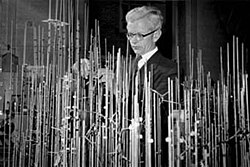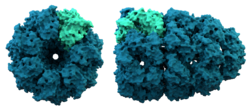Protein

Proteins are long-chain molecules built from small units known as amino acids, which are joined in a sequence by peptide bonds. Every sequence of amino acids becomes a specific final shape, allowing living things to use proteins as tiny machines to do work.
They are biochemical compounds.They have one or more polypeptides folded into a round or fibrous shape.[1]
A polypeptide is a single linear polymer chain of amino acids. The sequence of amino acids in a polypeptide comes from the DNA sequence of a gene.[2] The genetic code specifies 20 standard amino acids. Shortly after synthesis, some amino acids are chemically modified. This alters the folding, stability, activity, and function of the protein. Sometimes proteins have non-peptide groups attached, as cofactors.
Proteins are essential to all cells. Like other biological macromolecules (polysaccharides and nucleic acids), proteins take part in virtually every process in cells:
- Many proteins are enzymes that catalyze (help to happen) biochemical reactions and are vital to metabolism.
- Other proteins have structural or mechanical functions, such as in muscle and in cells. The cytoskeleton is a system of scaffolding that keeps cell shape.
- Other proteins are important in cell signaling, immune responses, and cell division
Formation
Proteins are formed by a process called "protein synthesis". The cell reads the genetic information of the DNA and translates it into a protein. In eukaryotes, this process begins in the cell nucleus and ends in the ribosome. In prokaryotes all of it is done in the cytoplasm.
Proteins have different functions depending on their shape and sequence. They can be found in meat or muscle. They are used for growth and repair, as well as for strengthening the bones. They help to make tissue and cells. They are in animals, plants, fungi, bacteria, and in the human body.
Muscles are mostly made of protein. When protein is digested, it is broken down into amino acids. These amino acids can then be used to build new protein. Proteins form an important part in foods like milk, eggs, meat, fish, beans, spinach, and nuts. There are four factors that determine what a protein will do. The first is the order of the amino acids. There are 20 different types of amino acids. The second is the little twists in the chain. The third is how the entire structure is folded up. The fourth is whether it is made up of different sub-units. Haemoglobin molecules, for example, are made of four sub-units.
Damaging mutations
Most proteins are enzymes, and mutations may slow them or stop them working. 50% of human cancers are caused by mutations in the tumour suppressor p53.[3][4] p53 is a protein which regulates cell division.[5]
Lifespan
Once formed, proteins only exist for a certain period. Then they are and recycled by the cell's machinery. A protein's lifespan is measured by its half-life. This covers a wide range. They can exist for minutes or years with an average lifespan of 1–2 days in mammalian cells.
Essential amino acids
Proteins are necessary in an animal's diet, since they cannot make all the amino acids they need (they can make most of them). They must get certain amino acids from food. These are called the essential amino acids. Through digestion, animals break down ingested protein into free amino acids. The amino acids are then used in metabolism to make the enzymes and structures the body needs.
There are nine essential amino acids for humans, which are obtained from food. The nine essential amino acids are: histidine, isoleucine, leucine, lysine, methionine, phenylalanine, threonine, tryptophan, and valine.[6] Meat contains all the essential amino acids humans need; most plants do not. However, eating a mixture of plants, such as both wheat and peanut butter, or rice and beans, provides all the essential amino acids needed. Soy products like tofu provide all the essential amino acids—as does quinoa—but these are not the only way to get the protein humans need.
Proteins were first described by the Dutch chemist Gerardus Johannes Mulder. Jöns Jacob Berzelius gave proteins their name.[7] Hundreds of other scientists have studied proteins since him.
Protein Media
John Kendrew with model of myoglobin in progress
Resonance structures of the peptide bond that links individual amino acids to form a protein polymer
The crystal structure of the chaperonin, a huge protein complex. A single protein subunit is highlighted. Chaperonins assist protein folding.
Related pages
References
- ↑ See protein structure for more on this topic.
- ↑ see Translation (genetics) and RNA splicing for a fuller account.
- ↑ Fersht, Alan 1999. Structure and mechanism in protein sequence. New York: Freeman, p1. ISBN 0716732688
- ↑ Sidransky D. and Hollstein M. 1996. Annual Review of Medicine 47, p285.
- ↑ Surget S; Khoury M.P. & Bourdon J.C. 2013. Uncovering the role of p53 splice variants in human malignancy: a clinical perspective. OncoTargets and Therapy. 7: 57–68. [1]
- ↑ "Amino acids: MedlinePlus Medical Encyclopedia".
- ↑ Hartley, Harold (1951). "Origin of the word 'protein'". Nature. 168 (244): 244. Bibcode:1951Natur.168..244H. doi:10.1038/168244a0. ISSN 0028-0836. PMID 14875059. S2CID 4271525.
Other websites
- Protein from the Harvard School of Public Health








